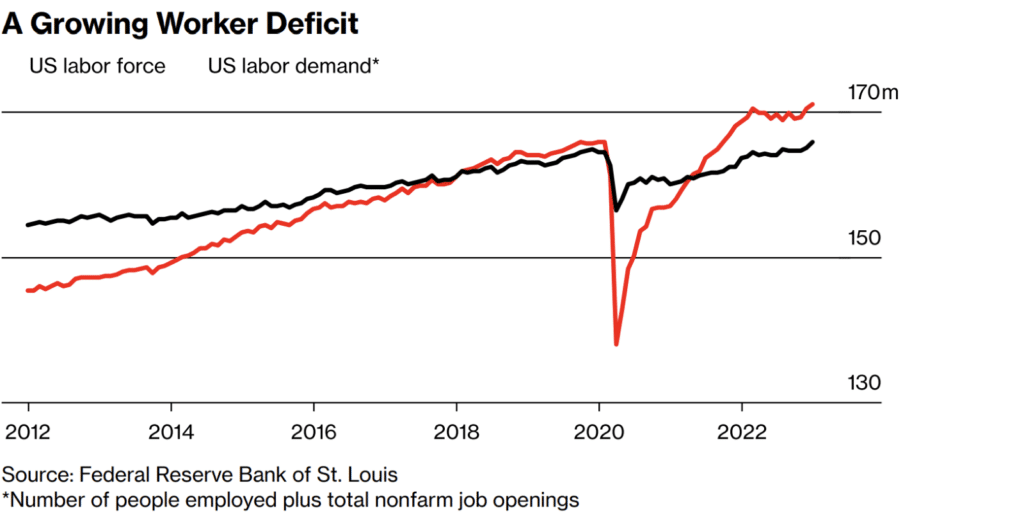Current educational and professional training programs cannot meet the worker shortage needs of a mobile and diverse workforce. This is a critical issue on multiple levels – from governmental policy and how it impacts funding allocation, to the private sector where there is a shortage of professionally trained workers. It has adversely affected everything, from agriculture to technology.
Worker Shortages Due to Covid
In the United States, there have been reports of worker shortages in various industries in recent years. This has been the result of several factors, including the COVID-19 pandemic, changes in government policies, and demographic shifts.
During the pandemic, many workers were laid off or furloughed due to business closures and decreased demand for services. This particularly held true in industries like hospitality, travel, and retail. As businesses reopened and demand increased, employers struggled to attract and retain workers. This resulted in worker shortages.
Current worker shortages have created a difficult environment for businesses and industries. This includes reduced productivity, higher labor costs, and difficulties in meeting the customer demand.
Employers Seeking to Hire Well-trained Staff Face Challenges
Some of these challenges include:
- Cost: Training can be expensive, and some employers may not have the resources to invest in training programs. This is particularly true for small businesses that may have a limited budget.
- Lack of Time: Employers may find it difficult to allocate time for training when there are pressing deadlines and other urgent tasks to attend to.
- Lack of Skilled Trainers: Not all employers have access to trainers with the expertise and experience to effectively train workers. In some cases, employers may have to rely on their own staff to provide training. This could be challenging if those staff members are already overburdened with other responsibilities.
How the Worker Shortages Have Negatively Impacted Nursing
The Natural Course of Aging
The first issue in the nursing shortage deals with age as both the general population. And, the workforce are reaching their golden years. In the next decade, a fifth of the population will be older citizens. Unfortunately, the same goes for the very registered nurses (RNs) caring for these patients. A third of the nursing workforce consists of professionals aged 50 years and above.
Bottlenecks in Education
Despite a promising career with job security, good compensation, and fulfilling work, there just aren’t enough nurses in the field today. The main bottlenecks in nursing schools are limitations on budget, faculty, staff, and other resources. The already limited number of teachers are looking to retire in the next decade, too. Filling these positions is challenging. This is because teachers are required to have higher educational attainment and more experience. But, they earn less than their counterparts in the field.
Solutions to the Nursing Shortages
As a matter of fact, not much can be done about the aging population, both for nursing staff and patients. However, focusing on the new generation of nurses is perhaps the best way to grow their presence in healthcare.
Worker Shortages in Construction
The Chips and Science Act came into effect in 2022. It aims to build a world-leading silicon microchip industry in the U.S. Recently, Intel broke ground on a new plant in Ohio. It is slated to cost $20 billion, including 10 labs, and employ 7,000 people when it is complete. That is the good news.
Ohio has long been known as part of the blue-collar heartland. However, the sad news is that even this state doesn’t have enough well-trained construction workers to build the plant.

Likewise, across the country, there are not enough firefighters, police officers, nurses, cooks, assembly line workers, teachers, welders, truck drivers – the list goes on.
The Solution to Worker Shortages
To be true, finding solutions for this problem of worker shortages will be critical for future growth in the U.S. Rethinking the way we train people by employing innovative technologies is necessary. Also, appealing to what they like and enjoy needs to be front and center of the effort. In fact, interactive video eLearning with gaming elements like badges and rewards helps enhance user engagement, understanding, and retention.
The uQualio Video4Learning video eLearning platform is the best digital, peer-to-peer training solution. Basically, it is a next-generation, award-winning, white-label platform for video-based training creation and distribution. uQualio has no upfront cost. It is a 100% pay-as-you-go, simple-to-use solution for any training needs.
With uQualio, you create and distribute your own video training program content for all types of training. These may range from employee onboarding, sales training, compliance certification, and operations management, to customer education, team building, hardware and software training.
At uQualio, we offer industry-leading innovation and customer support, built-in communication, data collection, and reporting, all in a low-cost, easy-to-use package.
Achieve Effective & Affordable Video Training
– uQualio is an award-winning, easy-to-use, all-in-one NextGen LMS software for any types of online video training.












